One Health PACT – First update of 2024
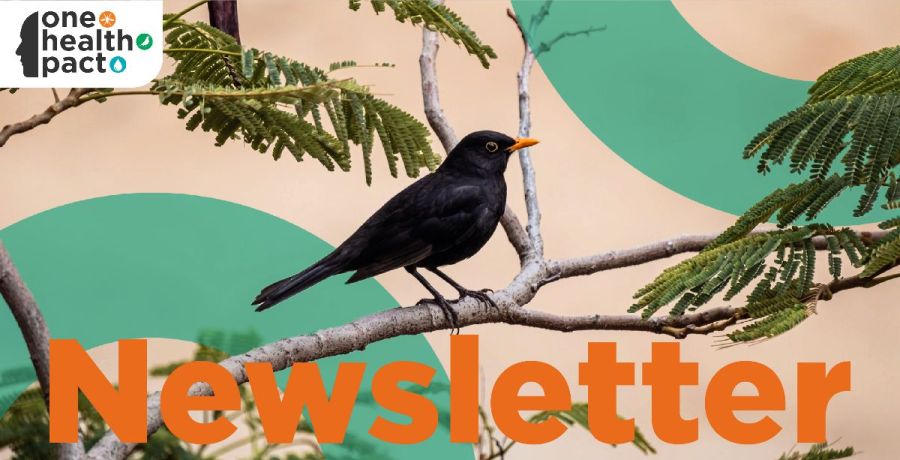
Annual meeting OHPACT
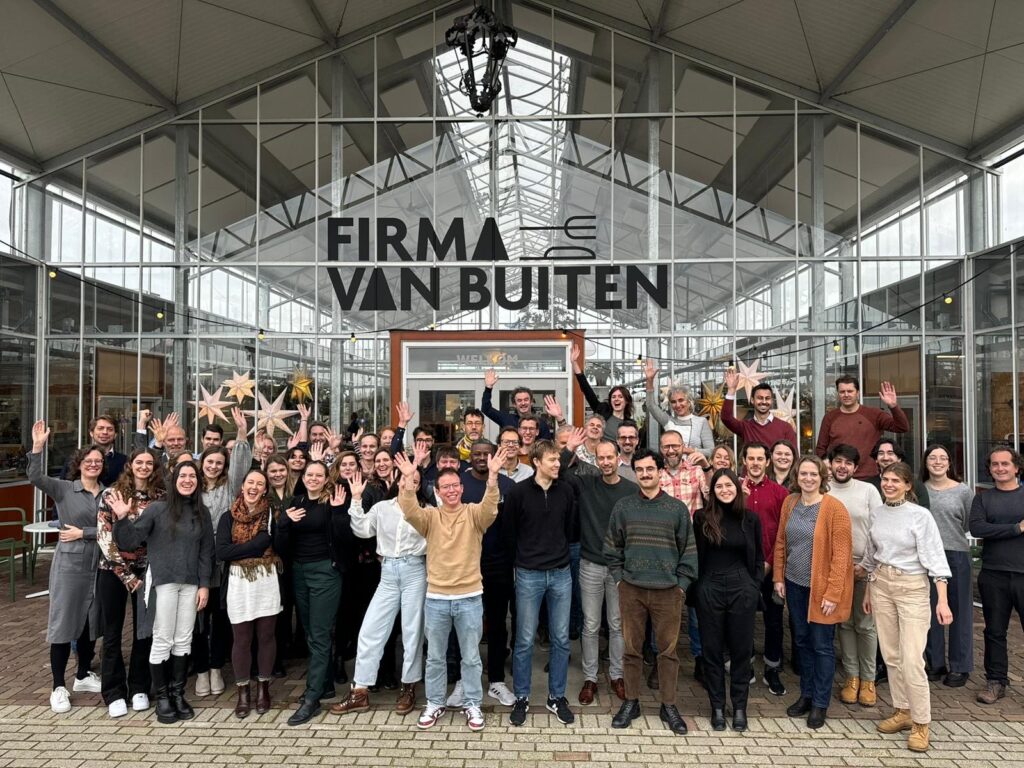
On Friday, December 15th, the One Health PACT annual meeting took place in Delft. The event featured presentations from the PIs representing each pillar, offering updates on completed work and outlining ongoing projects. Following this brief overview, the stage was turned over to the PhD candidates within each pillar, allowing for a more in-depth exploration of their ongoing research. A more detailed description of the PhD presentations can be found below.
The day concluded with closing remarks from Stella Koppel, who attended the annual retreat on behalf of NWO, and some inspirational words from Marion Koopmans. Subsequently, the floor was once again given to the PhD candidates, this time for a simulated press conference addressing a Bluetongue outbreak scenario. Despite challenging questions from the PIs, the PhD candidates demonstrated resilience and expertise. The event concluded with refreshments, providing an opportunity for further discussions.
PhD updates presented during the annual meeting
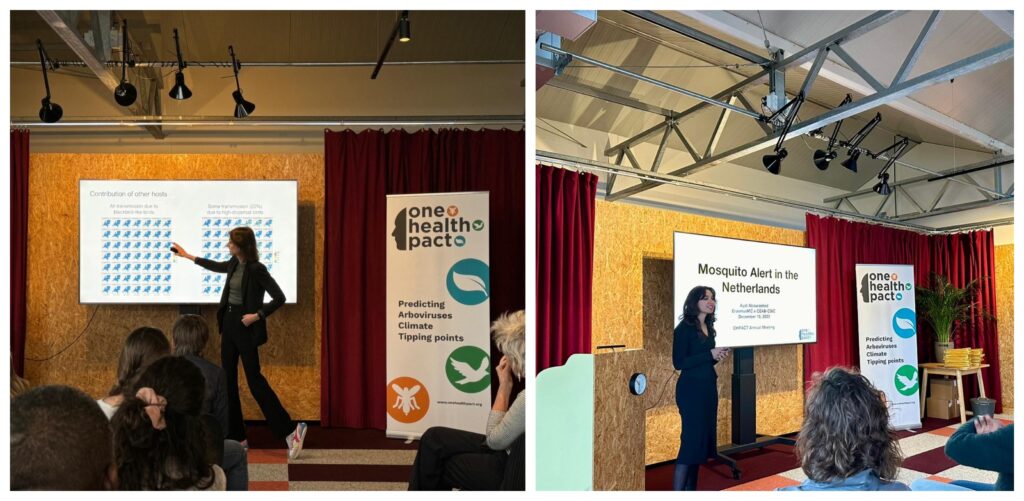
Pillar A – Ecosystem mapping
Ayat Abourashed highlighted the launch of the Mosquito Alert app and its success in 2021, with the Netherlands breaking records (over 5,000 reports submitted in 3 days!). Ayat gave an update about what has happened since then and how she has incorporated citizen science into spatial risk models. If you want to know more about Ayats presentation take a look at this blog post on the Mosquito Alert website link
Tjomme van Mastrigt presented preliminary results of an integrated population model of a key avian host for the Usutu virus. By combining capture-mark recapture data, territory counts and nest success data, this model showed how the breeding population of Common blackbirds (Turdus merula) in the Netherlands suffered from considerable mortality during the 2016-2018 Usutu virus outbreak. This resulted in a marked population decline.
Pillar B – Forecasting and early detection
Louie Krol unfortunately couldn’t attend the annual meeting. On his behalf Martha Dellar presented. The main message of the presentation was that Culex pipiens s.l. spatiotemporal distribution can be explained by a combination of climatological and land use/cover related factors. Climatological factors set the possible bandwidth and land use/cover shapes the local distribution. Modifying landscapes might thus be a possible avenue to mitigate the effects of climate change on mosquito spatiotemporal distribution.
Mariken de Wit presented her work on the transmission modelling of Usutu virus in the Netherlands. She showed the different components of the model and explained how the model is calibrated to the various sources of surveillance data collected in the consortium. First results suggested that successful introduction of the virus in the South of the country was the main driver of the observed spatial pattern in emergence.
Pillar C – Impact and severity assessment
Imke Visser presented her work on the effects of mosquito saliva on permeability of different skin layers and blood vessels. She identified the role of a protease in this process. Her presentation resulted to a very inspirational discussion! If you want to know more about Imke’s presentation please contact Imke.
Eleanor Marshall’s presentation focused on the differential susceptibility of human motor neurons to infection with USUV vs WNV. She found that motor neurons cannot be infected with USUV due to induction of a robust anti-viral response which is not induced upon infection with WNV. This finding may gave key insights into the reduced severity and incidence of neurological disease caused by USUV compared to WNV.
Pillar D – Interventions
Bijan Godarzi: gave a presentation about the lateral flow microarray immunoassay they are developing. He described the need for species-independent serological tools that can be used in the field and how they aim to address this by developing a species-independent lateral flow microarray immunoassay to detect and distinguish between WNV and USUV. Following optimization of the LMIA, the WNV and USUV LMIA results correlated well with “gold standard” WNV and USUV virus neutralization tests. In the next months he will use the developed LMIA to test bird tissue samples for the presence or absence of WNV and USUV NS1 antibodies. In collaboration with Jurrian and Henk, he will also assess how well the LMIA performs in a field setting.
Tom van der Most: gave an update on the intervention strategy of using insect-specific viruses to limit arbovirus transmission by mosquitoes. He evaluated the effect of Dutch isolates of Alphamesonivirus 1 and Negev virus on infection and transmission of West-Nile virus in laboratory Culex pipiens mosquitoes. He found that the proportion of WNV-infected mosquitoes was reduced with Negev virus, but the effect was visible at different timepoint, complicating the interpretation of these results.
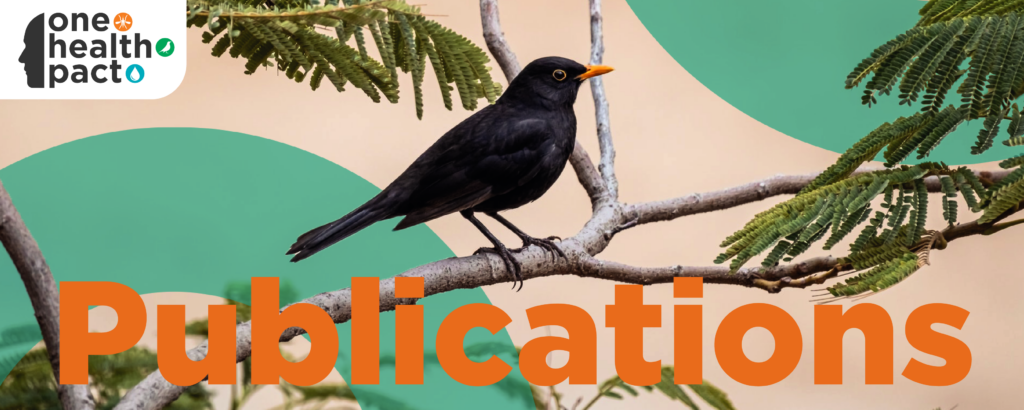
A species-independent lateral flow microarray immunoassay to detect WNV and USUV NS1-specific antibodies in serum
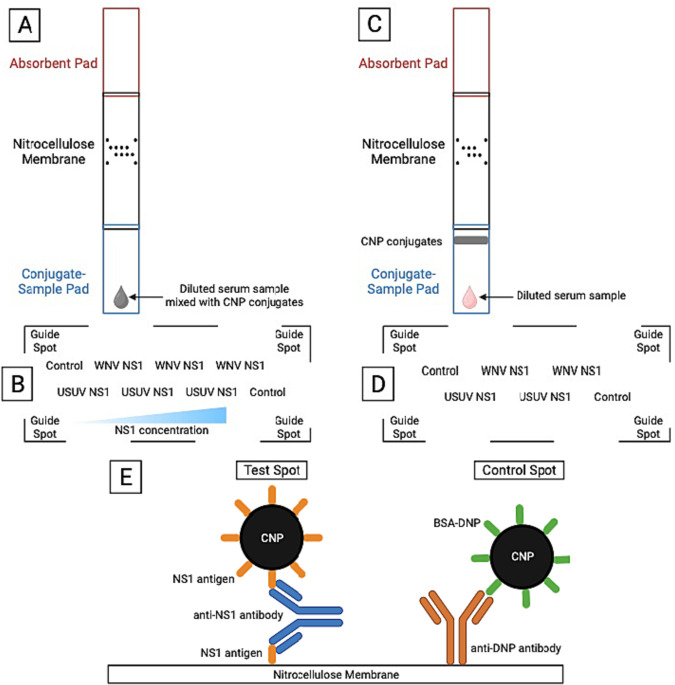
Bijan Godarzi, Felicity Chandler, Anne van der Linden, Reina S. Sikkema, Erwin de Bruin, Edwin Veldhuizen, Aart van Amerongen, Andrea Gröne

Current serological screening methods require access to a well-equipped laboratory and are not currently available for on-site analysis. As a proof of concept, we propose here a species-independent lateral flow microarray immunoassay (LMIA) able to quickly detect and distinguish between WNV Non-Structural 1 (NS1) and USUV NS1-specific antibodies. A double antigen approach was used to test sera collected from humans, horses, European jackdaws (Corvus monedula), and common blackbirds (Turdus merula). Optimization of the concentration of capture antigen spotted on the LMIA membrane and the amount of detection antigen conjugated to detector particles indicated that maximizing both parameters increased assay sensitivity. Upon screening of a larger serum panel, the optimized LMIA showed significantly higher spot intensity for a homologous binding event. Using a Receiver Operating Characteristics (ROC) curve, WNV NS1 LMIA results in humans, horses, and C. monedula showed good correlation when compared to “gold standard” WNV FRNT90. The most optimal derived sensitivity and specificity of the WNV NS1 LMIA relative to corresponding WNV FRNT90-confirmed sera were determined to be 96% and 86%, respectively. While further optimization is required, this study demonstrates the feasibility of developing a species-independent LMIA for on-site analysis of WNV, USUV, and other arboviruses.
The increasing complexity of arbovirus serology: An in-depth systematic review on cross-reactivity narrative review
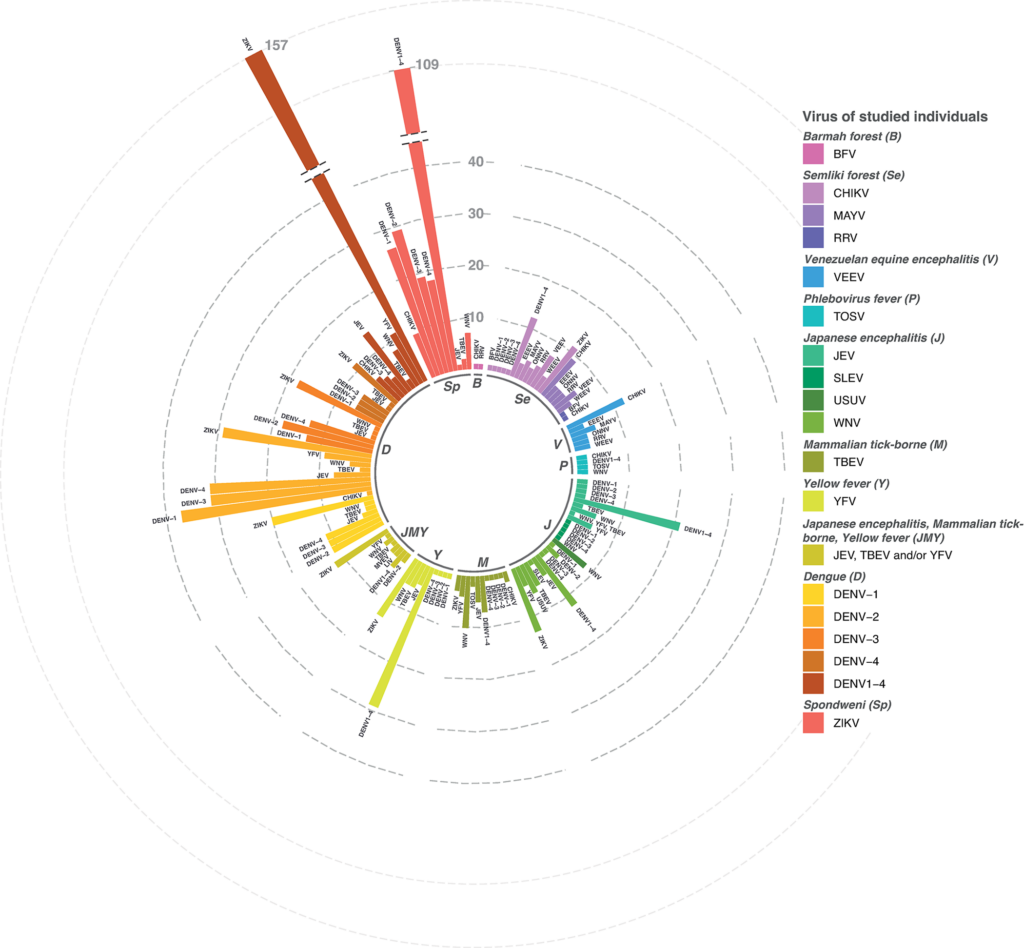
Louella M. R. Kasbergen , David F. Nieuwenhuijse, Erwin de Bruin, Reina S. Sikkema, Marion P. G. Koopmans
![]()
Arboviruses are notorious for triggering antibodies that may cross-react with (closely) related arboviruses, complicating interpretation of serology-based arbovirus diagnostics and of epidemiological surveys. This is further complicated by the rapid global spread of arboviruses, that may lead to increasing co-circulation of antigenically related arboviruses, and by the lack of detailed background information on the population tested, methods used and background arbovirus exposures such as prior infections or vaccinations.
Here, we aim to provide a better understanding of the complex cross-reactivity patterns as well as the current knowledge and knowledge gaps in differential arbovirus serology. We have done a systematic analysis of reported cross-reactivity patterns from published peer-reviewed articles, using a system that allows assessment of the quality of reported cross-reactivity results. We show that using this approach, the majority of studies lack details needed to reliably assess whether reactivity to antigens from different, related arboviruses is caused by antibody cross-reactivity, or if it reflects antibodies from multiple exposures to these different viruses
A One Health approach to predict, monitor and prevent arbovirus infections, an extensive case study from the Netherlands – Editorial

Reina S. Sikkema, Maarten Schrama, Barry Rockx, Marion Koopmans
In this special issue we provide initial results from a suite of studies aiming to generate a better understanding of the deeply complex set of factors that revolve around the emergence and spread of a novel arbovirus, as well as the measures that can be taken to monitor and mitigate the virus. All of this will be discussed in three sections: 1) determinants of vector and ecosystem changes; 2) animal reservoirs and how to monitor them; 3) human health impact assessment and interventions. In this special issue we present the results of the first two years, so many questions remain to be answered. However, already we show the complexity of different hosts, ecosystems and climate and interacting risk factors.
The potential of resilience indicators to anticipate infectious disease outbreaks, a systematic review and guide
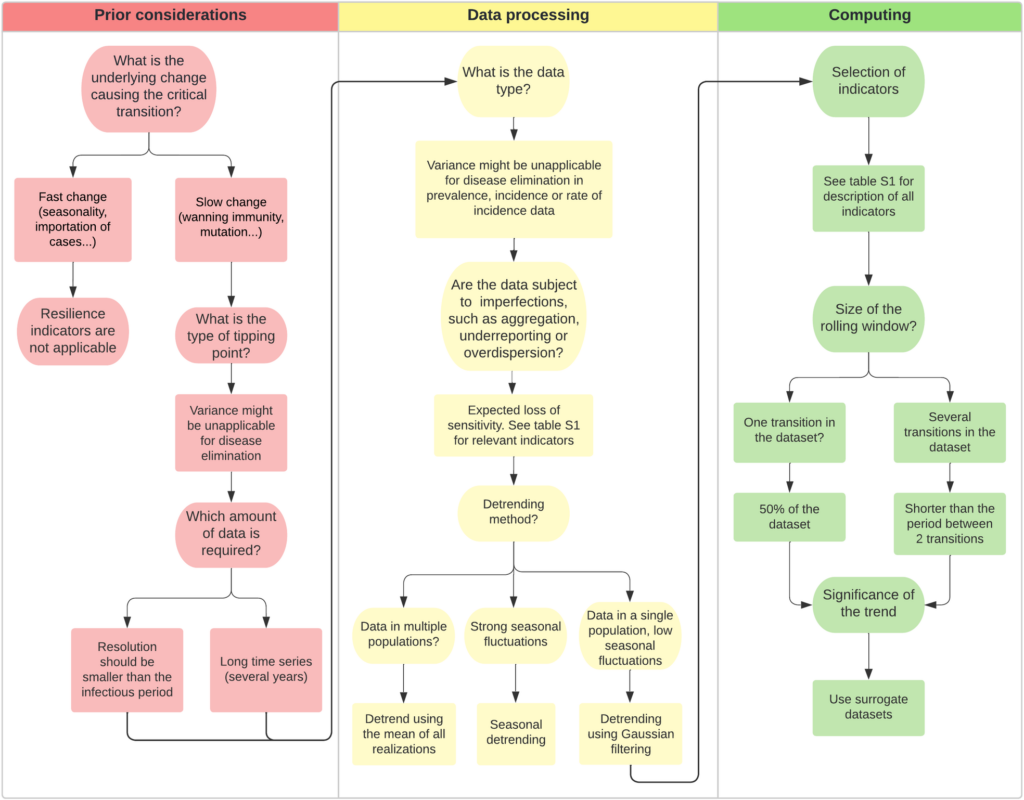
Clara Delecroix, Egbert H. van Nes, Ingrid A. van de Leemput, Ronny Rotbarth, Marten Scheffer, Quirine ten Bosch

To reduce the consequences of infectious disease outbreaks, the timely implementation of public health measures is crucial. Currently used early-warning systems are highly context-dependent and require a long phase of model building. A proposed solution to anticipate the onset or termination of an outbreak is the use of so-called resilience indicators. These indicators are based on the generic theory of critical slowing down and require only incidence time series. Here we assess the potential for this approach to contribute to outbreak anticipation. We systematically reviewed studies that used resilience indicators to predict outbreaks or terminations of epidemics. We identified 37 studies meeting the inclusion criteria: 21 using simulated data and 16 real-world data. 36 out of 37 studies detected significant signs of critical slowing down before a critical transition (i.e., the onset or end of an outbreak), with a highly variable sensitivity (i.e., the proportion of true positive outbreak warnings) ranging from 0.03 to 1 and a lead time ranging from 10 days to 68 months. Challenges include low resolution and limited length of time series, a too rapid increase in cases, and strong seasonal patterns which may hamper the sensitivity of resilience indicators. Alternative types of data, such as Google searches or social media data, have the potential to improve predictions in some cases. Resilience indicators may be useful when the risk of disease outbreaks is changing gradually. This may happen, for instance, when pathogens become increasingly adapted to an environment or evolve gradually to escape immunity. High-resolution monitoring is needed to reach sufficient sensitivity. If those conditions are met, resilience indicators could help improve the current practice of prediction, facilitating timely outbreak response. We provide a step-by-step guide on the use of resilience indicators in infectious disease epidemiology, and guidance on the relevant situations to use this approach.
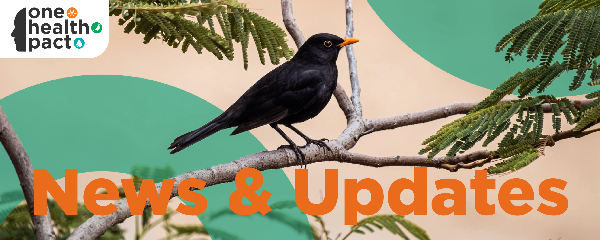
OHPACT at the Epidemics conference
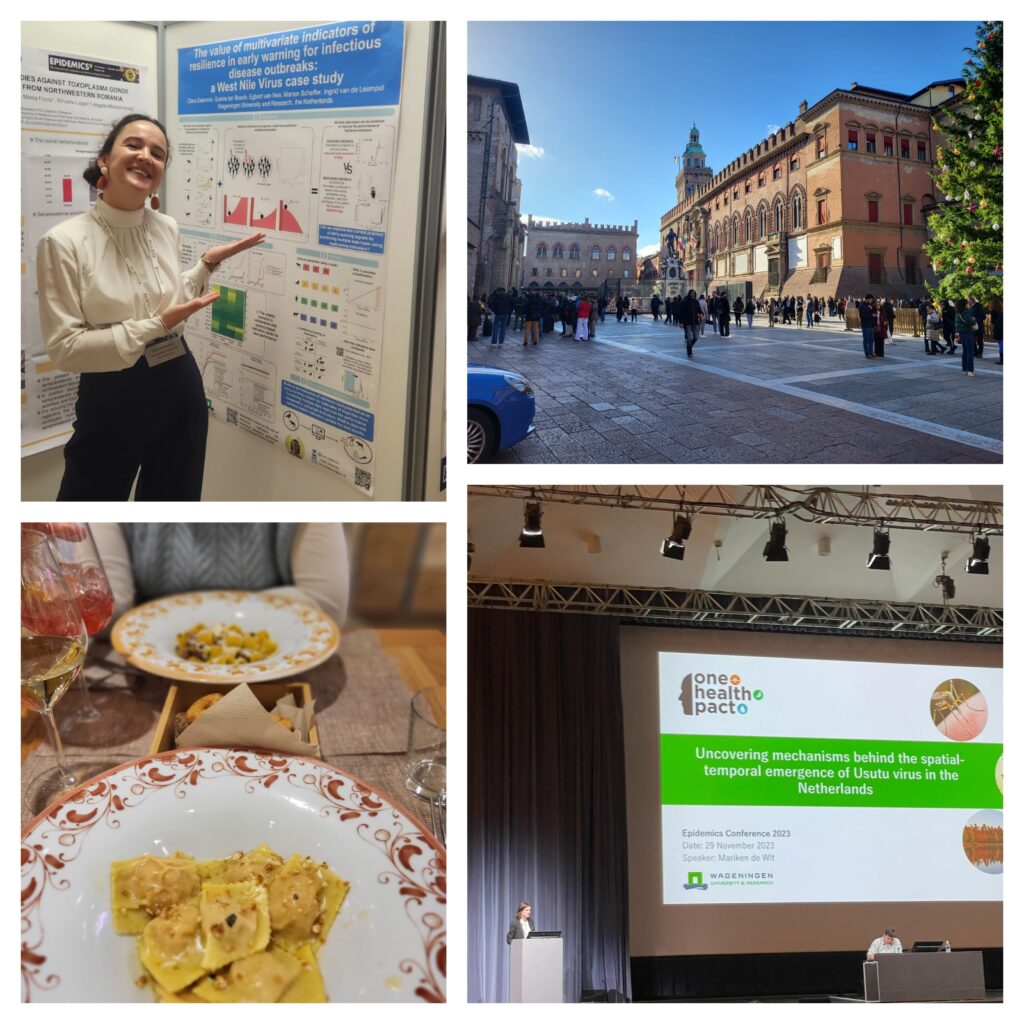
One Health PACT was well represented at the latest edition of the Epidemics conference in Bologna as Afonso, Clara, Mariken, Quirine, and Hans all attended. All three PhD students presented their latest research findings. Afonso presented his work on ‘Indirect interaction between an endemic and an invading pathogen: a case study’. Mariken gave a talk entitled: ‘Uncovering mechanisms behind the spatial-temporal emergence of Usutu virus in the Netherlands’, and Clara shared her work on “The value of multivariate indicators of resilience in early warning for infectious disease outbreaks: a West Nile virus case-study”. We met a lot of interesting infectious disease modellers, including some that presented their work in the monthly QuantPact meetings earlier last year. We were excited to see several projects about West Nile virus and other vector-borne viruses and enjoyed discussing these with all presenters. We also lost track of the amount of pasta we ate, but you need good food to talk science, right…?
The ESCAIDE in Barcelona
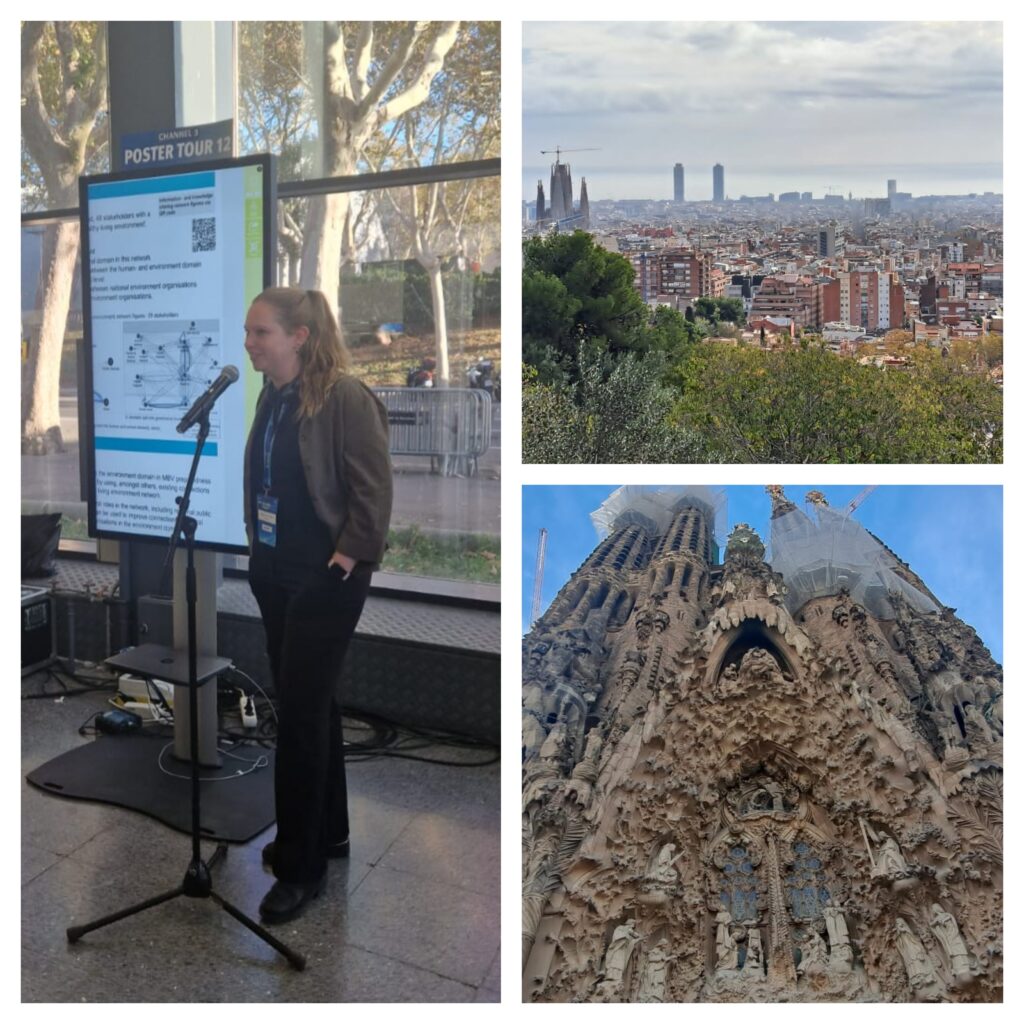
In November 2023, I had the privilege to participate in ESCAIDE held in Barcelona—an annual event organized by the ECDC offering lots of enlightening talks and discussions around Public Health and infectious diseases. Throughout the conference, the significance of One Health, the need for effective use of new data sources and effective communication were recurring topics in both the plenary sessions and poster presentations.
During a plenary session on wastewater surveillance, Marion Koopmans approached wastewater surveillance from the perspective of the genomics revolution and highlighted the great potential of metagenomics in surveillance. Later in the day, the spotlight shifted to One Health, and the impact of changing urban environments on infectious diseases. This offered a good transition into the poster presentation session “emerging infectious diseases” during which I presented our stakeholder analysis work. The stakeholder analysis revealed a notable lack of collaboration with the environment domain and an underrepresentation of regional and local stakeholders in the context of mosquito-borne virus preparedness and response. The presentation sparked a stimulating discussion with multiple public health experts, providing valuable insights.
Beyond the conference sessions, the three days in Barcelona offered plenty of opportunities to explore the city and enjoy the good food! – Written by Pauline de Best
Fieldwork expedition through the Pantanal of Brazil – Louella Kasbergen
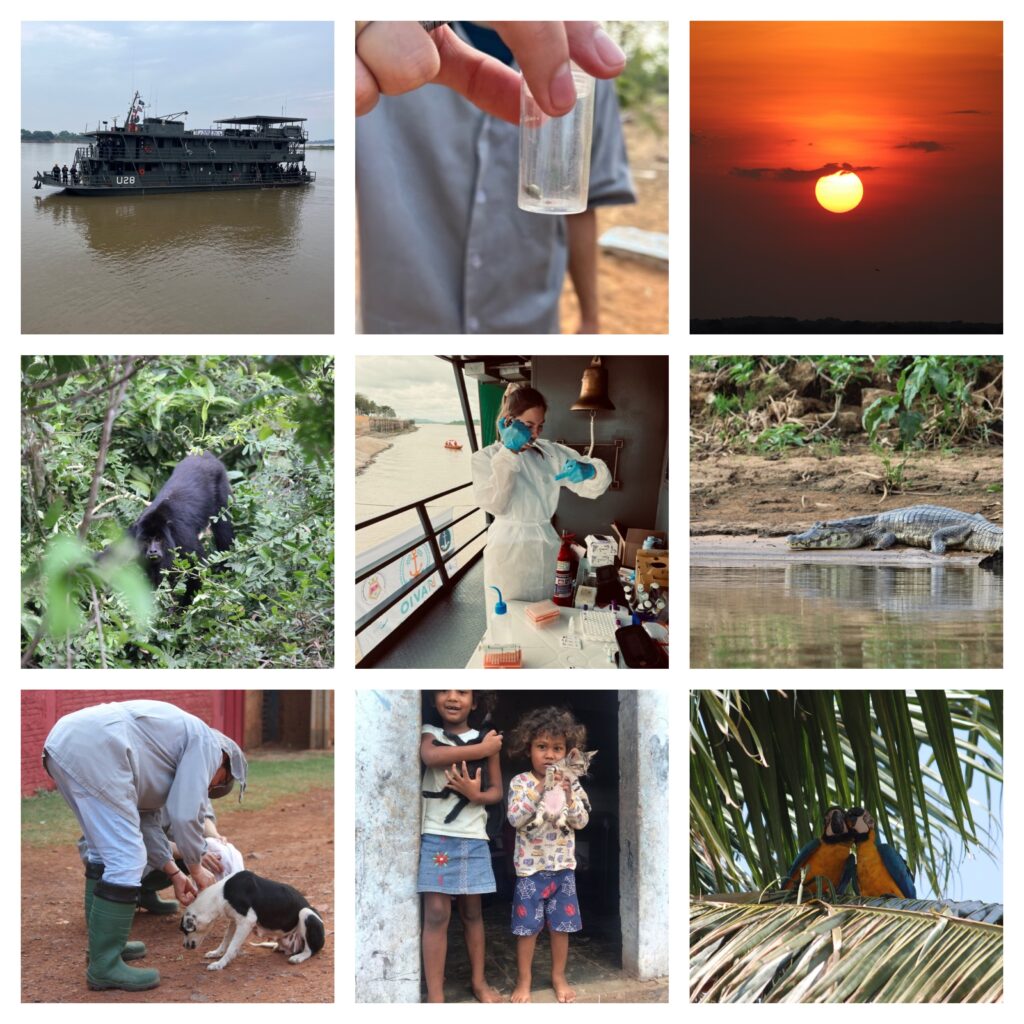
On the border with Paraguay and Bolivia, we have been visiting isolated riverside communities in the Brazilian state Mato Grosso do Sul in the tropical wetland area Pantanal. We did this by boat together with the Brazilian Navy. This project was part of the CLIMADE consortium, aiming to identify circulating viral pathogens in these communities, as well as the impact of climate change, to identify priority locations for surveillance and improve preparedness and control of possible future outbreaks. The fieldwork included collecting mosquitoes, ticks, river/waste water, animal feces and human blood, using a mobile lab on the navy ships to test for viruses and virus antibodies. Additionally, we provided direct healthcare to the individuals living in these remote areas. It was definitely a very unique and special experience!
Society of Vector Ecology (SOVE)
PhD candidate, Ayat Abourashed, was selected as the new Student Director for the Society of Vector Ecology (SOVE) back in September 2023. As Student Director, Ayat co-moderated the student presentation session. She also had a poster to show the results of the MosquitoWise survey as distributed in the Netherlands and Spain. (Poster in the image below).
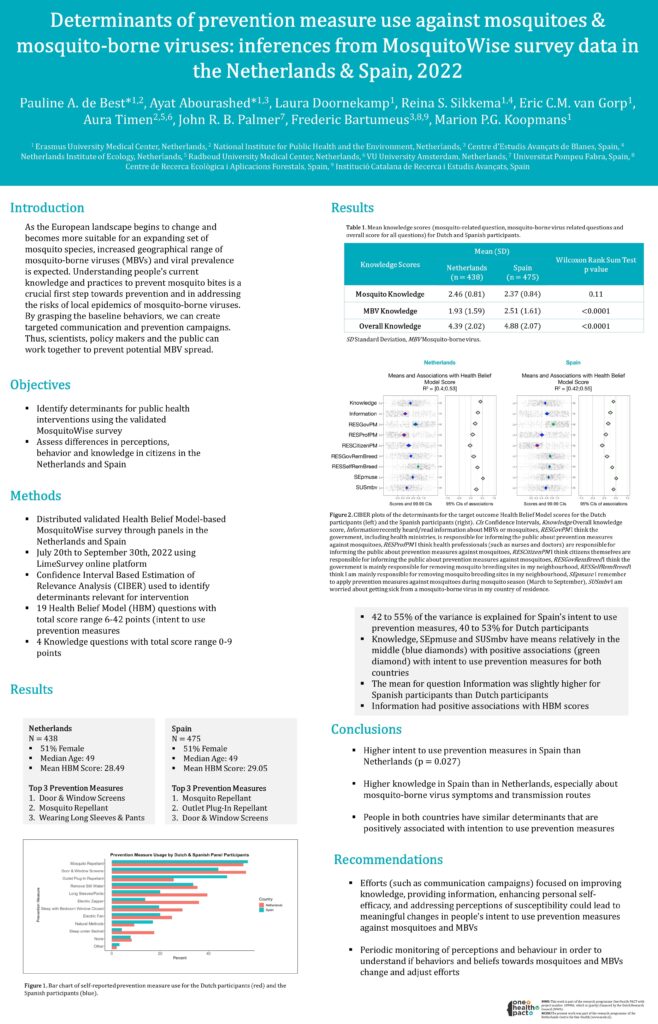
MMED 2023 in South-Africa
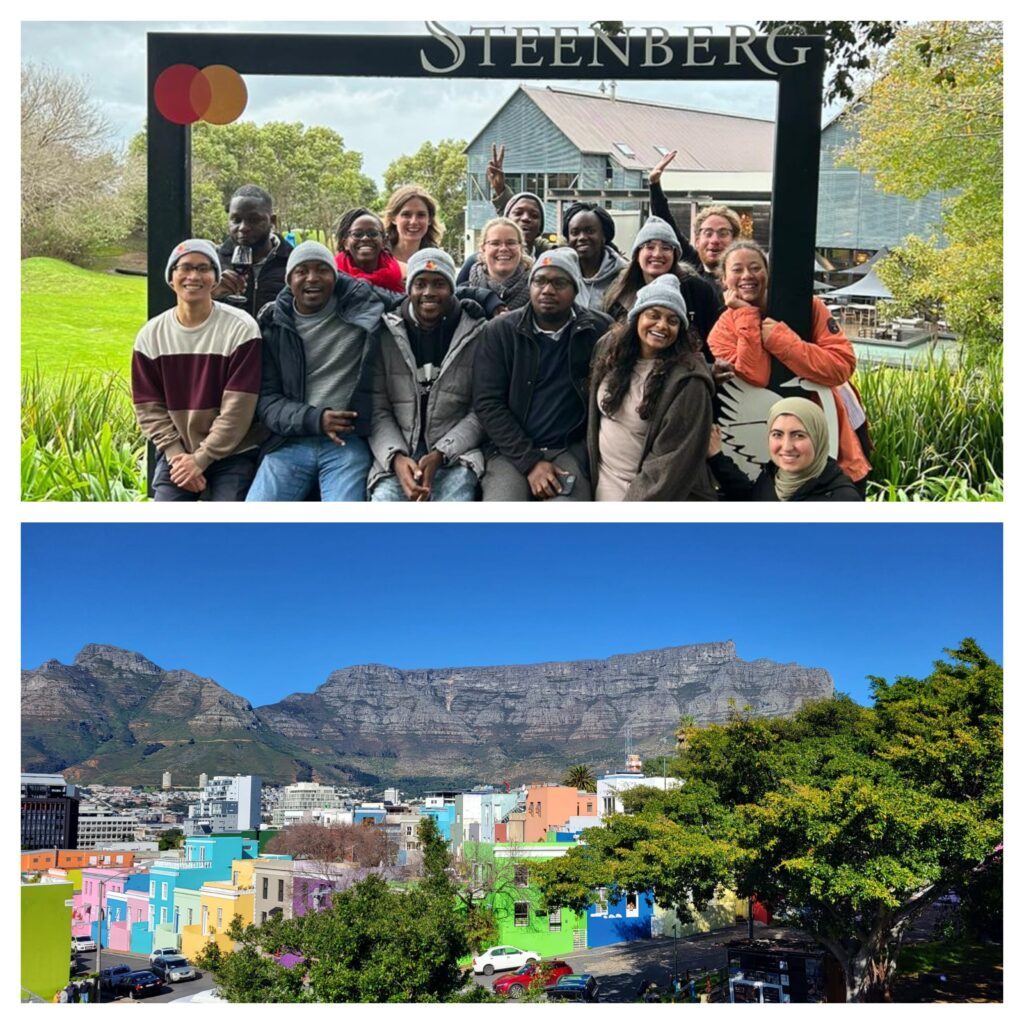
Last summer I attended the two-week Clinic on Meaningful Modelling of Epidemiological Data (MMED 2023) hosted by the African Institute of Mathematical Sciences in Cape Town, South Africa. The participants came from diverse backgrounds as the purpose was to connect people with mathematical backgrounds to people with a public health background. In the first week some courses were tailored to our background to get us up to speed such that everyone had a good understanding of both epidemiology and modelling by the second week. In the second week we worked on group projects where my group worked on sample size calculations for a dengue intervention trial using a modelling approach to obtain estimates of the force of infection by age. We enjoyed the project so much that we are still working on it! For more info on the programme, see here:https://www.ici3d.org/MMED/ – Written by Mariken de Wit
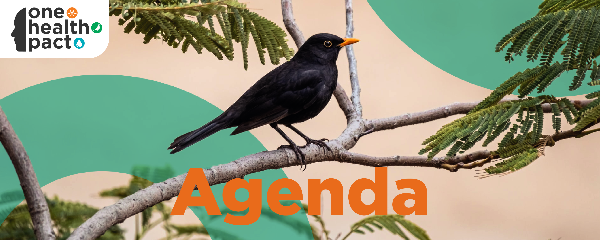
Next One Health Pact meeting

The next OHPACT meeting will take place on the 15th of March. Location to be determined.
Join the “Early career network” of the NCOH

Young NCOH is a network for PhD students and post-docs working in the field of One Health. Aim of the network is to share knowledge and expertise in One Health related disciplines, which can lead to new collaborations in research and help you develop as a scientist.
As a member you get the opportunity to participate in a range of events including masterclasses, site visits and networking meetings tailored to your needs. Registration is completely free of charge.
Register now at www.ncoh.nl/about/young/
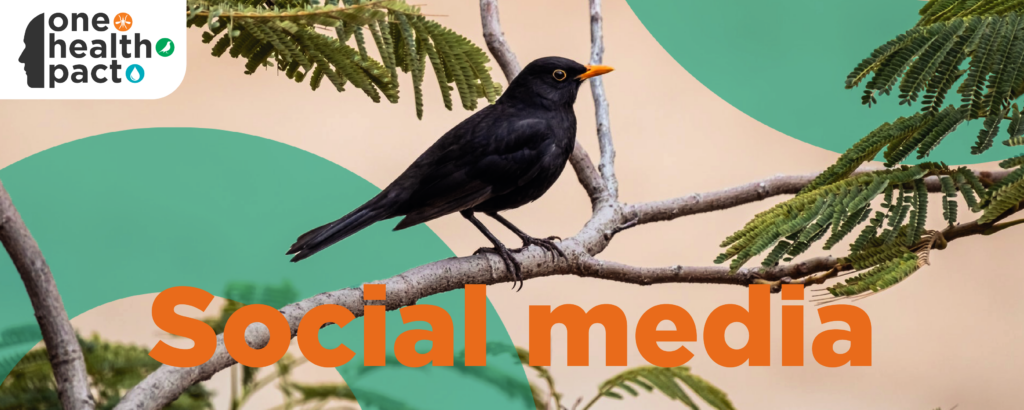
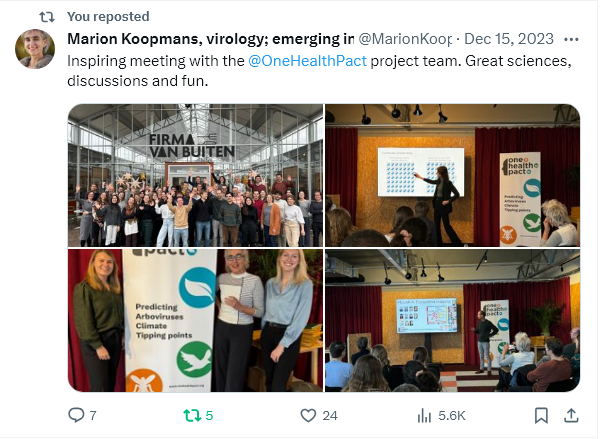
Follow One Health PACT on twitter: www.twitter.com/OneHealthPact and LinkedIn
Do you have anything to share rapidly? Use @OneHealthPact and we will forward your message.
Don’t have a twitter account: Email onehealthpact.communication@erasmusmc.nland the OIOs will post on your behalf.
One Health PACT
Powered by
 |
 |
This newsletter is part of the research programme One Health PACT with project number 109986, which is (partly) financed by the Dutch Research Council (NWO).
